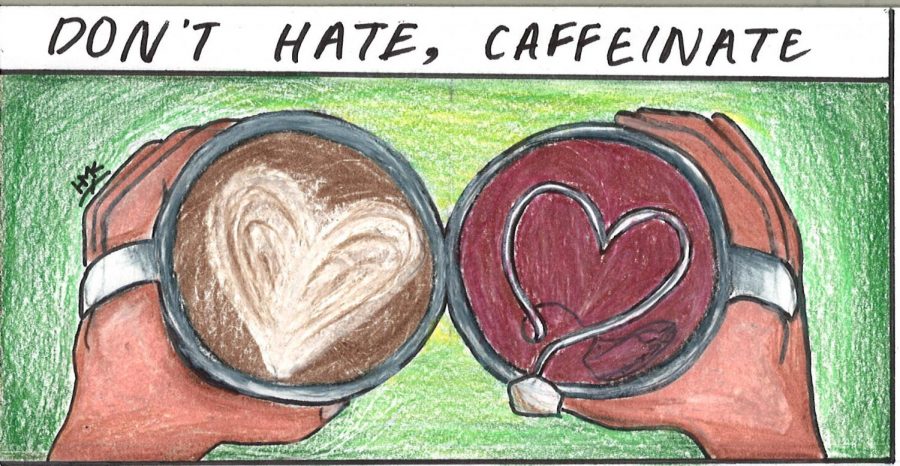Fe’brew’ary Debate: Coffee or Tea?
February 2, 2018
 Monotone beeps pulse and echo through the room, and you force yourself from underneath the warmth of your cotton covers. Your eyes rest on the key appliance in your house: your brand-new espresso machine.
Monotone beeps pulse and echo through the room, and you force yourself from underneath the warmth of your cotton covers. Your eyes rest on the key appliance in your house: your brand-new espresso machine.
But what type of drink do you want to start your day? A non-fat latte? A cappuccino or a caramel macchiato? Flat white or an americano? You make your decision and brew your favorite espresso beans and watch the delicious crema form on the surface of your drink.
Coffee- that warm, dark brown brew’s glory towers over tea- the astringent liquid that is formed by sacks of leaves that have been sitting in your cabinet for months or possibly years.
Coffee provides warmth, joy, and many health benefits to people. In a Harvard study, it has been proven that coffee drinkers are less likely to die at a young age from some illnesses and that it prevents Type 2 Diabetes, heart disease, strokes, dementia, and cancer. Coffee also contains nutrients such as antioxidants, magnesium, chromium, and insulin.
Aside from the health benefits, coffee also provides a warm, trendy social scene that tea sometimes can lack. Coffee shops pop up everywhere- from Starbucks and Dunkin Donuts franchises to small local cafés. No matter where someone goes, they will be able to find a coffee shop, not so; for, “tea shops.”
Many social events are held at small coffee shops such as open mics, meetings, interviews, dates, or study sessions. They provide quiet places to study or chat, which is beneficial to the common student or businessman or woman.
The most popular use, however, is for caffeine. All coffee and espresso, with the exception of decaf, contains caffeine, a stimulant that helps to wake people up, or keep them awake, much more effectively than tea.
With all the obvious benefits, coffee is the best choice to make.

Green tea, sweet tea, even an extra-hot-lightly-sweetened-vanilla-chai-latte-with-coconut-milk, tea is a drink enjoyed all over the world and has established itself as a better tasting alternative to coffee.
Tea can be incorporated into a balanced, heathy diet to add a boost of energy. A 16 oz. Chai Latte from Starbucks has roughly 95mg of caffeine compared to the 225mg found in a Caffé Americano, according to The Center of Science in the Public Interest.
While highly caffeinated drinks may sound appealing to over-worked and sleep deprived high school students, research has shown that too much caffeine can interfere with sleep, which can, in turn, negatively impact learning. However, caffeine can be completely safe for most individuals as long as it’s not overdone. Everything in moderation, folks.
Frappuccino’s are not fooling anyone; sugar and cream are frequently added to coffee to make the bitter taste more appealing, but they also stir in unnecessary calories. Tea is a more versatile alternative and comes in many different flavors, such as peppermint and blood orange, and natural sweeteners like honey can be added for taste.
For those concerned about tea staining their pearly whites- don’t be. Even though black tea can cause teeth to become discolored just as easily as coffee, you can always just pick a different blend of tea! White tea is low in antioxidants called tannins that can cause teeth to become yellow.
Although it’s true that tea tends to be less popular than coffee in America, it is enjoyed by about half of the entire world population. According to Oxford Research Encyclopedia, tea is the second most consumed beverage next to water.
So, this Fe-brew-ary, instead of placing their usual Macchiato order, students should ask for tea instead.



